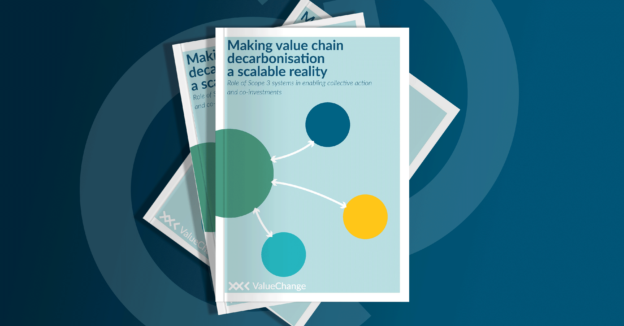VCI launches system of systems for Scope 3 action
Dino De Francesco
On July 19th, Value Change Initiative (VCI) launched its vision for credibly accounting, claiming and reporting Scope 3 emissions. The publication entitled “Making value chain decarbonisation a scalable reality: Role of Scope 3 systems in enabling collective action and co-investments” is the first to propose a comprehensive systems framework to verify, track and claim Scope 3 emission reductions. It introduces a “system of systems”, which ensures integrity and credibility for Scope 3 accounting while enabling collaboration and co-investments. This system of systems captures a snapshot of a developing market space for Scope 3 reporting, emerging from practice and challenges that existing solutions have not been able to solve. This will empower organisations to make more effective strategic choices in Scope 3 investments, such as setting up interventions in a way that facilitates transparency, or learning how to enable collaborations where interventions can be claimed by two or more value chain partners.
The publication is the output of the Systems Lab, a robust multistakeholder process with the input of 31 VCI members, convened in 2022. It was released along with a webinar highlighting its vision and key insights, where we were joined by two guest panellists representing the agricultural sector. Jeff Seale, Director of Environmental Strategy & Climate Policy at Regrow Ag, and Josiah McClellan, Head of Carbon Assets at Land O'Lakes, Inc. They both represent key actors in the Scope 3 ecosystem and actively participated in the Systems Lab. In the webinar, they discussed the implications of the system of systems to Scope 3 accounting in practice, and the business case for developing Scope 3 systems.
What is the system of systems bringing to the table?
We all know the metaphor of six blind people approaching an elephant from different angles. No one knows the full picture so all of them base their perceptions on the one part of the elephant that they can touch – the one touching the tail thinks an elephant is like a rope, the one touching the tusk thinks it’s a spear.

This is true for any complex system, where everyone is equally right in their own way. However, you need to see the big picture to know how things really relate to each other. This is what the system of systems is aiming to do. Understanding the bigger picture in this pioneering context can help organisations identify their own roles in relation to other actors, as well as opportunities to take action. This setup presents a way to organise that can align with current and future standards, including different approaches to traceability and Chain of Custody. The options explored here offer a way forward for complex value chain networks facing realities such as imperfect traceability.
The system of systems is composed of three interconnected systems which support collaboration and co-investment in the value chain. The Impact Verification System verifies emission reductions, allowing companies to have verified GHG mitigation outcomes. The Tracking system tracks the attribution of verified outcomes to those with a Right to Claim that information, avoiding double counting and claiming. Finally, the Trading/Transfer system facilitates the transactional transfer of information for use in climate reporting, providing opportunities for collaboration and co-investment. They are all connected by a Registry, which is a centralised “source of truth” that enables credible claiming and impact transfer by keeping records of activities in all three systems.

Discovering how to take action on Scope 3
Both Jeff Seale and Josiah McClellan agree that companies have the ambition to reduce emissions, but there has been a lack of “how” to implement ideas. “The Systems Lab publication has the potential to connect ambitions to credible and real climate action,” Jeff Seale states.
Josiah McClellan agrees:
Actors working with Scope 3 already know what they need to do and who should do it – but the answer as to how to do it has been elusive. The system of systems creates the roadmap between point A and point B, allowing companies to move past the continuous dead ends that have been hampering Scope 3 action until now.
And it’s not a moment too soon, as upcoming EU and other regulations are set to come into effect.
The three interconnected systems as well as the registry allow companies to know exactly where emission reductions are taking place and who has contributed to them. Having a consistent process and clear rules through a registry, standardised verification and commonly agreed impact allocation enables integrity and credibility in the system. Companies sourcing from the same suppliers can reliably invest in the same intervention and clearly divide the claims and benefits, while avoiding double counting. Meanwhile thanks to the system safeguards, no company will be able to claim emission reductions that they have not generated, invested or traded in, bringing more credibility and value to Scope 3 claims.
There is a business case for Scope 3 systems
The system of systems captures what the Scope 3 impact market could look like, allowing organisations to trade or transfer impact between themselves. This would facilitate return on investment, but that’s not the only business case supporting Scope 3 systems.
Josiah McClellan says the system of systems can function as a navigational North Star for the company, helping create more productive conversations with leadership with clear indications of what investments are achieving. As Scope 3 action shifts to different departments and types of funding, the system of systems provides confidence that longer-term investment to build on the system will pay off.
Jeff Seale believes the system of systems can bring credibility and transparency to the Scope 3 ecosystem, eventually returning value to project developers and farmers:
Systems for Scope 3 action need to be low cost and low touch to provide economic value for farmers and ultimately allow for scaling. The high rigor and scientific backing of the system allow estimated outcomes to meet ever-evolving criteria and regulations, making sure that programmes will be compliant with current and future standards.
The next step is scaling up
The system of systems is an enabler of credible action in Scope 3, even when open questions remain. Our guest panellists are optimistic about the future of the system – the next step is scaling up and making it even simpler and more actionable.
Jeff Seale shares: “The system of systems may look complicated, but it’s actually an attempt to simplify a complex setting. Hopefully, we will be able to simplify it further in the future, because reducing Scope 3 emissions is critical not only for climate goals but the future of our food supply.”
Josiah McClellan echoes the sentiment. “We’re going in the right direction, now we just need to get more actors involved to scale up the system.”
The system of systems is a first step to setting a common ground for all stakeholders in the Scope 3 ecosystem. VCI aims to inspire Scope 3 actors to continue improving the systems framework and help the marketplace evolve – so that companies can work together to take credible Scope 3 action.

